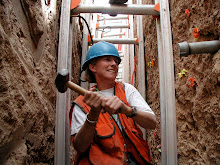Wikipedia has the following light to shed on the matter:
Bog bodies, which are also known as bog people, are the naturally preserved human corpses found in the sphagnum bogs of Northern Europe and the British Isles. Unlike most ancient human remains, bog bodies have retained their skin and internal organs due to the unusual conditions of the surrounding area. These conditions include highly acidic water, low temperature, and a lack of oxygen, combining to preserve but severely tan their skin. Despite the fact that their skin is preserved, their bones are generally not, as the acid in the peat dissolves the calcium phosphate of bone.As it happens, there is a Mummy Museum in Oldenburg Germany. Take a look.
The German scientist Dr Alfred Dieck catalogued the known existence of over 1850 northern European bog bodies in 1965. Most, although not all, of these bodies have been dated to the Iron Age...Some of the most notable examples of bog bodies include Tollund Man and Grauballe Man from Denmark and Lindow Man from England.
Ever since the Iron Age, the bogs in these coastal areas have been used for digging peat, which is used as fuel. In fact, abundant peat fuel was one reason the Dutch had a booming economy in the 17th century, commonly referred to as 'the Dutch Golden Age.' With all that peat mining, you can imagine that once in a while, peat diggers have come across bog bodies.
My husband Tim now calls my ancestors 'Bog People.' A few hours later, I managed to find out that his ancestors, way back in the 15th century, were residents of the Bavarian Forest in what is now southern Germany. So he is descended from 'Lederhosen People.'

No comments:
Post a Comment